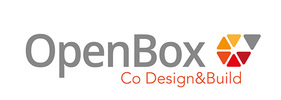Co Design&Build
|
|
At present, OpenBox is constructing office space for messaging services in the Lyon region. OpenBox was selected in particular for the environmental performance of its offer and the technical solutions proposed to meet the E+C- certification and BREEAM Good rating.
Frédéric Lamblot, director of OpenBox designs, Héloïse Couvert, director of the Etamine Lyon design firm, and Geoffrey Michalet, Etamine project manager discussed this in further detail: Why take a commitment towards achieving E+C- certification? Frédéric Lamblot : At the outset, only BREEAM certification was the aim. However, our client wanted to go one step further, so as to comply with the group policy of being carbon neutral. The technical solutions proposed for construction of buildings form an integral part of this ambitious objective. Consequently, in the space of just a few weeks, we reviewed and adjusted our offer – notably by working in collaboration with Immasset (Assistant Contracting Authority), we studied the Etamine proposals to take account of the necessary adaptations, notably structural in nature, whilst respecting the architectural creation and managing additional costs. Our flexibility and collaborative work allowed us to make a new design proposal which met these challenges. The commitment to a result in terms of energy performance reassured the client on this key part of the specifications. How close are you to certification? Héloïse Couvert: Etamine was selected by OpenBox and the client to manage certification. Our design office was responsible for designs and advised OpenBox as to the possible construction solutions available. Geoffrey Michalet : All of the buildings will be BREEAM Good certified; but the head office also wanted E1-C1 level E+C- certification. Therefore, we proposed replacing the initially planned concrete structure with a primary and secondary wooden structure, which required several adjustments to the overall design. This element has a significant impact on the Carbon footprint. In total, this represents 66 dm3 of wood per m² of surface area. We additionally worked alongside the Fobis design office for energy requirements (the E part of the certification). LED lighting, dual-flow controlled mechanical ventilation, installation of CO² sensors, solar-controlled glazing and interior blinds, for instance, all played a significant part in energy optimisation of the building. Héloïse Couvert: We then acted as a link to the certification body. We supervise the project and answer any questions as and when they arise. Certification will be issued upon handover of the building. What does this represent for OpenBox? Frédéric Lamblot: At OpenBox we are all immensely proud to be involved in this process, to construct high-performance buildings with a low carbon footprint. We are already anticipating future regulations. We strive to make proposals and be innovative, which is highly rewarding. We hope to be able to offer this certification to other clients in the near future. Find out more about Etamine Understanding this new certification The construction sector represents close to 45% of national energy consumption and close to 25% of greenhouse gas emissions (source: Ministry of Ecological Transition). Learning to reinvent oneself and seek innovative technical solutions to reduce the carbon footprint of our buildings is more urgent than ever in the fight against global warming. The Energy + Carbon – (E+C-) certification was developed by the State so as to increase and promote buildings which were energy positive and with a low carbon footprint. It is a voluntary and experimental certification which is a forerunner to the future RE2020 energy regulation for new builds (of which application has been put back to summer 2021). The E+C- certification is different to other environmental certifications in force in the construction sector as it relies on a new calculation method based on two indicators:
Comments are closed.
|
Catégories
All
Archives
January 2024
|



 RSS Feed
RSS Feed